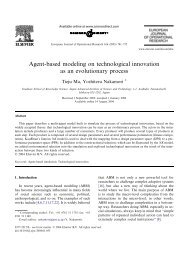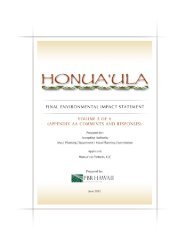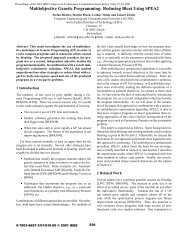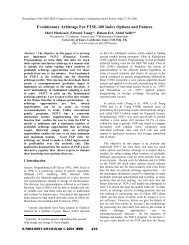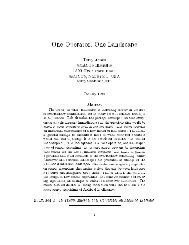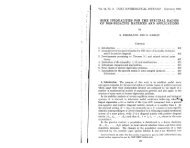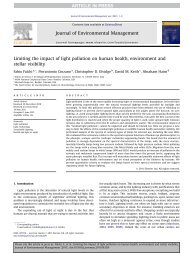4 description of the human environment, potential ... - Lee Altenberg
4 description of the human environment, potential ... - Lee Altenberg
4 description of the human environment, potential ... - Lee Altenberg
Create successful ePaper yourself
Turn your PDF publications into a flip-book with our unique Google optimized e-Paper software.
Final Environmental Impact Statement<br />
route will approximate <strong>the</strong> alignment shown on <strong>the</strong> current TMK map (Figure 3), and thus<br />
will run diagonally from Kaukahi Street, through <strong>the</strong> Native Plant Preservation Area, to <strong>the</strong><br />
sou<strong>the</strong>ast corner <strong>of</strong> <strong>the</strong> Property.<br />
The Native Plant Preservation Area contains known archaeological and cultural sites.<br />
Therefore, to protect <strong>the</strong> integrity <strong>of</strong> <strong>the</strong>se sites and native plants, <strong>the</strong> Native Plant<br />
Preservation Area will remain undisturbed and development will be prohibited, with <strong>the</strong><br />
exception <strong>of</strong>: 1) <strong>the</strong> Kanaio-Kalama trail, which will transverse through <strong>the</strong> Native Plant<br />
Preservation Area; and 2) a Nature/Cultural trail that will border <strong>the</strong> Native Plant<br />
Preservation Area.<br />
In <strong>the</strong>ir July 31, 2009 letter, Nä Ala Hele e proposed development <strong>of</strong><br />
walking trails and <strong>the</strong> preservation <strong>of</strong> <strong>the</strong> stepping stone trail will provide recreational<br />
<br />
Overall, Honuaÿula will not be a gated community; however builders <strong>of</strong> some individual<br />
<br />
areas. No gated community areas have been proposed, but it has not been determined if<br />
any areas would be gated or where <strong>the</strong>se areas would be located within <strong>the</strong> Property or at<br />
what phase <strong>the</strong>y would be built. However, any gated area would not be so restricted to<br />
prohibit anyone with a legitimate reason from accessing an area. Specifically, any gated<br />
area would not be designed to exclude access to any cultural or archaeological resources.<br />
Typically gated communities evoke images <strong>of</strong> mini mansions in exclusive enclaves, but<br />
restricted access multi-family townhouse and o<strong>the</strong>r higher density developments can also<br />
<br />
upper income level residents, <strong>the</strong>re are also many gated communities that are geared to<br />
average homebuyers. Although gated communities are <strong>of</strong>ten criticized as elitist and<br />
homogeneous, data suggests that gated communities are not necessarily reserved only for<br />
<strong>the</strong> rich (Nasser 2002). The 2001 American Housing Survey conducted by <strong>the</strong> U.S. Census<br />
Bureau reported that more than seven million households live in a type <strong>of</strong> gated<br />
community. The statistics also show that residents <strong>of</strong> gated communities belong to many<br />
different demographic types, not just <strong>the</strong> wealthy. Gated communities are popular with<br />
young families with children, retirees, second-home buyers, pr<strong>of</strong>essionals, and many<br />
o<strong>the</strong>rs. The elderly have been attracted to gated communities since <strong>the</strong> 1970s. O<strong>the</strong>r<br />
<strong>potential</strong> buyers include empty nesters who are away frequently on vacations and young<br />
double-income families in which no one is home during <strong>the</strong> day (Blakely 1999). For<br />
second-home buyers, gated communities are especially attractive for <strong>the</strong> security <strong>the</strong>y<br />
provide during long periods <strong>of</strong> vacancy (Blakely 1999).<br />
Research shows that motivations for living in a gated community reflect, to varying<br />
degrees, a range <strong>of</strong> social values (Blakely & Snyder 1997). Some people are drawn to<br />
gated communities for prestige; some are looking for privacy; some want to protect<br />
<strong>the</strong>mselves from crime and traffic (Blakely & Snyder 1997). For some, gated communities<br />
provide an added measure <strong>of</strong> security, less traffic, and increased pedestrian safety, a<br />
CHAPTER 4 DESCRIPTION OF THE HUMAN ENVIRONMENT, POTENTIAL IMPACTS, AND MITIGATION MEASURES<br />
118



